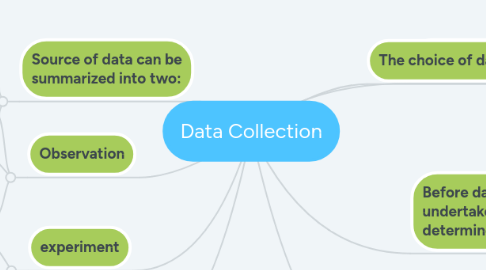
1. Source of data can be summarized into two:
1.1. Primary source
1.1.1. Data which is collected by the researcher herself using systematic process and has not previously published.
1.1.1.1. May not match your need.
1.1.1.2. Access may be difficult or costly.
1.1.1.3. May save some costs and time.
1.1.1.4. Allow for longitudinal studies.
1.1.1.5. Validity of some secondary data (e.g. internet sources)
1.2. Secondary source
1.2.1. Data which is obtained from existing trusted resources either in raw form or compiled form.
1.2.1.1. Commonly match to your need.
1.2.1.2. Original.
1.2.1.3. Sometimes involve some costs and time.
1.2.1.4. May be not appropriate for longitudinal studies.
1.2.1.5. Validity of the process in collecting the data.
2. Observation
2.1. Definition
2.1.1. Observation is a design method to identify the problems that can arise when people interact with products, services and environments.
2.2. Example
2.2.1. how people move around a shopping centre, or how people in the street use their mobile phones.
2.3. Strategy
2.3.1. Jot down the event,
2.3.2. taking photos or video which let you to analyse the material after the event.
3. experiment
3.1. Definition
3.1.1. An experiment is a controlled study in which the researcher attempts to understand cause-and-effect relationships.
3.2. Example
3.2.1. if we want to determine if a medical procedure is effective, we can randomly assign people to either undergo the procedure (the treatment group) or not (the control group).
4. Interview
4.1. Face to face
4.2. Computer-Assisted Personal Interview
4.3. Postal/Mail survey
4.4. Dropoff-Mailback and Dropoff-Pickup
4.5. Telephone interview
5. A systematic process to obtain an adequate data set for statistical analysis.
6. Before data collection is undertaken, a researcher must determined:
6.1. The target population.
6.2. Whether sample is necessary.
6.3. Variables to be obtained or measured.
6.4. Scale of measurements involve.
7. The choice of data collection is strongly depending on the types of statistical studies:
7.1. Descriptive:
7.1.1. to describe about the population (i.e. survey poll).
7.2. Comparative:
7.2.1. to compare 2 or more populations.
7.3. Experimental:
7.3.1. investigator intervenes to control conditions to look at relationship between variables.
7.4. Observation:
7.4.1. investigator collects data without reaching to the objects.
8. Survey
8.1. Definition
8.1.1. A survey solicits information from people; e.g. pre-election polls; marketing surveys.
8.2. Example
8.2.1. Questioners, census and others.
